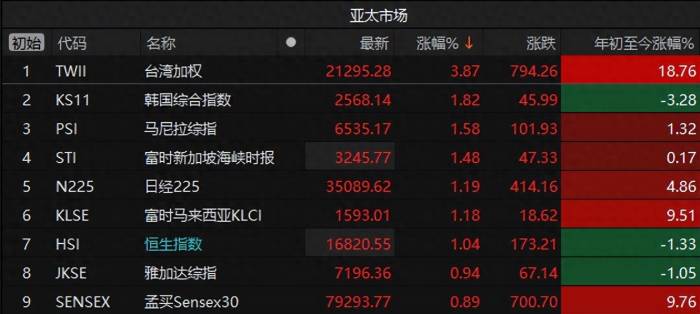Asia-Pacific Stock Markets Surge While A-shares Dive
The global financial landscape has undergone a tumultuous series of events, particularly driven by fluctuations in Japan's monetary policy and concerns surrounding the U.S. economy. Recently, as tensions eased, it appears that what started as a panic sell-off in global equity markets has shown signs of stabilization. Central to this stabilization was the Bank of Japan's latest strategy, which revealed a significant depreciation of the yen. Such movements prompted a rebound in U.S. Treasury yields and reduced the urgency for investors to unwind yen carry trades, thereby boosting Asian markets and U.S. stock futures alike. This sudden wave of optimism enveloped the Asia-Pacific stock markets, with notable rises in indices: the Taiwan Weighted Index surged by nearly 4%, the South Korean Composite Index saw an increase of almost 2%, and Japan's Nikkei 225 briefly jumped over 3%. However, amidst the rally, China's A-shares remained an outlier, trailing behind despite the widespread gains elsewhere.
Delving deeper into the recent financial narrative, it is essential to understand the underlying causes of the volatility, notably dubbed “Black Monday.” The phenomenon can be encapsulated by three principal keywords: the excessive rally of U.S. stocks, fears of a looming recession within the United States, and the significant appreciation of the yen that followed. Investors had previously capitalized on the depreciating yen, pouring funds into high-yielding U.S. assets, thus reaping rewards from both ends of the exchange. However, this advantageous cycle flipped into a disastrous one as the yen began to strengthen relative to the dollar, coupled with declining U.S. stock prices, leading to widespread liquidation in the markets.
Advertisement
Recent statements from Masayoshi Uchida, the Deputy Governor of the Bank of Japan, underscored this shift in sentiment. He noted that the central bank is committed to maintaining its monetary easing stance as long as economic forecasts hold steady. Uchida emphasized that interest rates would only be adjusted in response to emerging financial instabilities. He voiced his belief in the potential for a soft landing for the U.S. economy, despite acknowledging recent market volatility as being particularly severe. Indeed, the apprehension surrounding both a recession in the U.S. and the impacts of continued yen carry trades has led to considerable market jitters.
Despite these fears, there remains a consensus that the market may have overreacted to the recession narrative. Although there are identifiable signs of economic slowdowns in both the U.S. and Japan, the situation does not appear severe enough to warrant aggressive tightening from Japanese monetary authorities. The recent economic data support this, revealing declines in key indicators: Japan's industrial output dropped by 7.3%, household consumption fell by 1.4%, and new housing starts suffered a setback with a decrease of 6.7%. Such statistics cast doubt on the sustainability of continued interest rate hikes from the Bank of Japan.
Once the Bank of Japan exhibited signs of capitulation, a notable depreciation of the yen ensued, with the dollar against the yen climbing more than 2%. This devaluation was met with an allied surge in both Asian markets and the U.S. stock futures, indicating a general market sentiment that a stable yen is critical for easing the adverse effects of recent market jitters. Market participants seemed to agree that as long as the yen does not continue to trend upwards, the aftershocks of yen carry trades that had plummeted would begin to diminish.
Adding to the financial narrative was a shining star in the tech world: Lumen Technologies, a fiber optic company, announced a massive $5 billion order, fueled by a surge in demand driven by AI advancements. This news sent Lumen's stock soaring by an astounding 93%. The ripple effects were felt throughout related sectors in China's A-shares market, where companies like Yangtze Optical Fibre and Tongding Interconnection Technology saw their stock prices hit the upper limits allowed in daily trading.

In a landmark achievement for commercial space ventures, China successfully launched its “Qianfan Constellation,” also known as the G60 constellation, from the Taiyuan launch site. This mission saw the launch of 18 satellites aimed at forming a low-Earth orbit communication network, marking a significant milestone in China's burgeoning commercial space industry. Experts have dubbed this year as the dawn of commercial space, predicting considerable benefits for the aerospace and satellite internet sectors. In response, stocks related to this market segment surged dramatically, with several companies, including Yuetong Technology and Shanghai Copper, reaching their daily limits as investors reacted optimistically to the news.
However, not all sectors followed this upward trend. Companies involved in domestic computing power experienced a steep decline. Firms such as Zhongke Shuguang, Unisplendour Corporation, Inspur Information, and Cambricon Technologies all faced dramatic drops in their stock prices, despite the absence of overt negative news. Some analysts speculate that potential oversupply issues tied to artificial intelligence-related hardware, particularly low-margin offerings from companies like NVIDIA, may have contributed to this decline.
As the trading day came to a close, market statistics revealed subtle fluctuations in indices. The Shanghai Composite Index posted a minor gain of 0.09%, while the ChiNext Index fell by 0.43%. Meanwhile, the Hong Kong’s Hang Seng Index rose by 1.22%, and the Hang Seng Tech Index edged up by 1.03%. Even as trading volumes dwindled sharply to around 590 billion yuan—falling below the elusive 600 billion mark—analysts pointed toward varying performances across sectors. Coal, utility, defense, telecommunications, and petrochemical industries led the rally, while agriculture, real estate, pharmaceuticals, textiles, and retail faced downturns.
As the global markets continue to navigate these complex dynamics, it is crucial for investors to remain prudent in their approaches. The stock market inherently carries risks, and the ongoing fluctuations underline the importance of independent analysis and comprehensive understanding rather than reliance on sensational news trends.
Leave a Reply